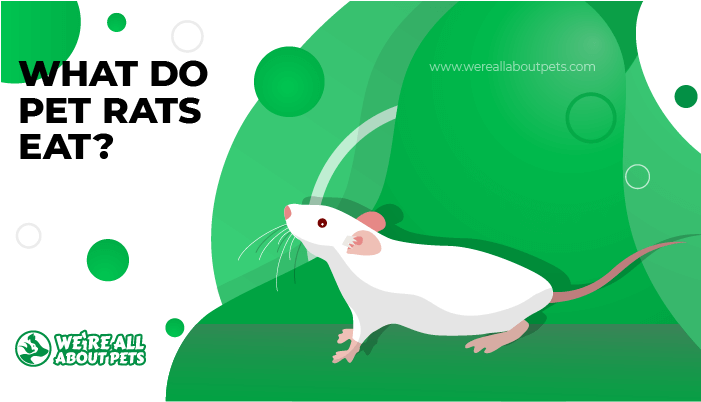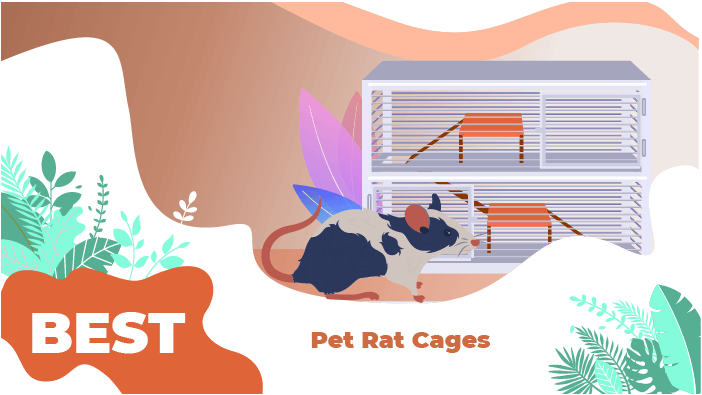How To Care For A Pet Rat?
This page contains affiliate links. We may earn money or products from the companies mentioned in this post through our independently chosen links, which earn us a commission. Learn More
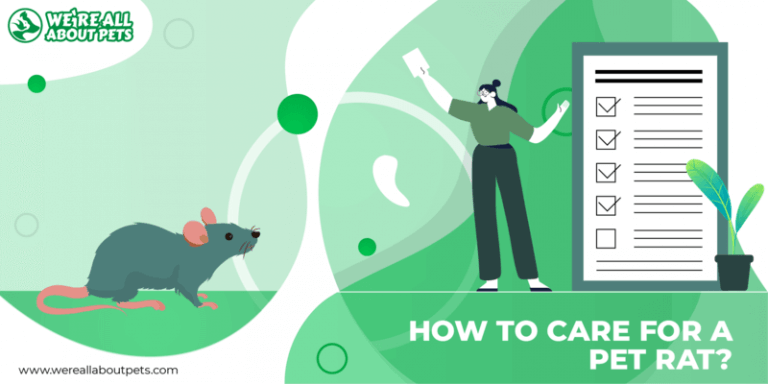
General Stats:
- Pet Type: Small animal
- Size: 9 to 11 inches (plus 8 inches tail)
- Diet: Omnivore
- Lifespan: Up to 3 years
Though many people think of rats as dirty animals, they are actually very clean and have the potential to make great pets. If you’re looking for a low maintenance pet, a fancy rat might be the perfect companion for you.
Rats don’t require a lot when it comes to getting them set up. As long as you have a large wire cage and the necessary supplies, you’re good to go. Here’s what you need to know about caring for a pet rat.
Habitat Setup For Pet Rats
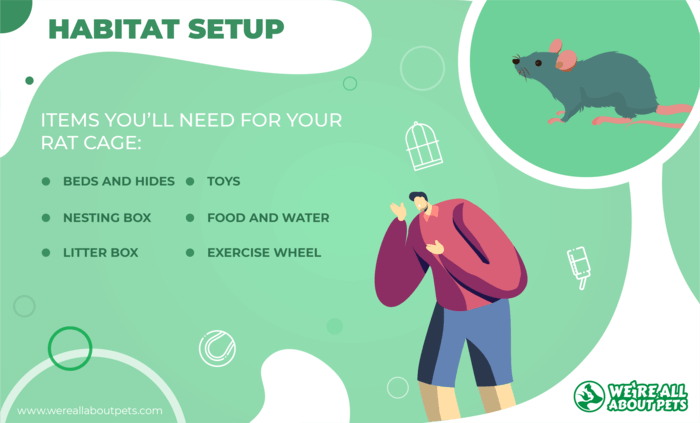
Rats are active animals, so they require a fair bit of space. When keeping rats, you need to decide how many you plan to keep so you can choose a cage large enough.
At a very minimum, you need a cage 12×24 inches for two small rats (a minimum of 2 square feet). A multi-level cage with ramps and different areas for playtime is a great option.
The more rats you keep, the more space you’ll need. A large wire cage like the kind you’d use for a guinea pig works well.
Look for something with a solid bottom to contain your rat bedding but make sure the entire cage isn’t solid or you may run into problems with ventilation and odor.
Wire cages should have horizontal bars to allow for climbing and the wire spacing should be small enough that your rat can’t fit through but wide enough that his feet won’t get stuck.
Here are some of the items you’ll need for your rat cage:
- Beds and Hides – Rats love to sleep in hammocks and soft beds, so provide a few of these items in addition to things like cardboard boxes where your rat can hide.
- Nesting Box – Provide your rats with a place to nest such as cardboard boxes filled with soft nesting material. Another more durable option is a flowerpot turned on its side. Rat bedding should be safe and non-toxic – wood shavings work well but avoid using cedar or pine shavings.
- Litter Box – Rats are fairly clean animals, so you shouldn’t be surprised if you find them going to the bathroom in one part of the cage. You can make cleaning easier on yourself by placing a litter box in this area. Use the same bedding you do elsewhere – never use cat litter.
- Exercise Wheel – Your rats need plenty of exercise to stay healthy, so provide exercise wheels large enough to safely accommodate your new pet’s size.
- Toys – Provide your rats with plenty of toys including chew toys and things to keep them mentally engaged. Something as simple as a few empty tubes from paper towels will do nicely.
- Food and Water – Choose food bowls that are heavy enough not to tip over and sturdy enough not to scratch. Provide fresh water in a sipper bottle for small pets.
In addition to choosing how to set up your rat’s cage, think about where you’ll keep it as well.
Put the cage out of direct sunlight and away from air vents and windows to prevent drafts. Place the cage in a relatively quiet area as well but not so out of the way that your net pets won’t have social contact.
Also Read: The Cost Of Owning A Rat
Pet Rat Diet
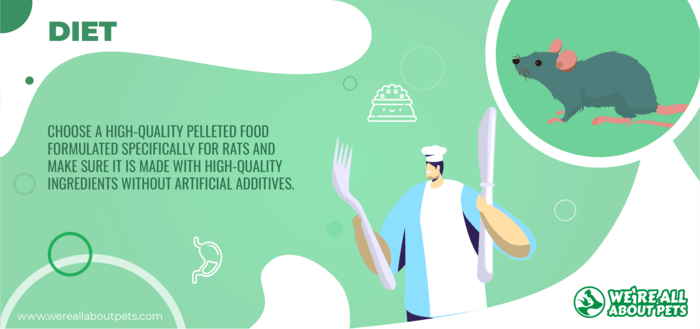
In the wild, rats are omnivorous and likely to eat a wide variety of foods from seeds and grains to insects and vegetation. Pet rats require a certain balance of nutrients, like any other pet, and a healthy diet is the key to your pet’s long-term health and wellness.
Here are some quick facts about the ideal rat diet:
- Choose a high-quality pelleted food formulated specifically for rats and make sure it is made with high-quality ingredients without artificial additives.
- Supplement your rat’s diet with fresh food like fresh fruits, vegetables, roasted nuts and seeds (unsalted), and whole grains.
- Avoid feeding your rat hamster, guinea pig, or ferret food – these foods won’t provide the right combination of nutrients your rat needs for optimal health.
- Provide your rat with occasional treats like small dog biscuits, pieces of cooked chicken or boiled egg, even mealworms or dried crickets.
In addition to food, be sure to provide your pet with unlimited access to fresh water as well.
In the wild, rats get the majority of their hydration from food, but you’ll need to provide a water bottle. A small pet water bottle is perfectly fine – just make sure to clean it and refill it on a daily basis.
Pet Rat Veterinary Care
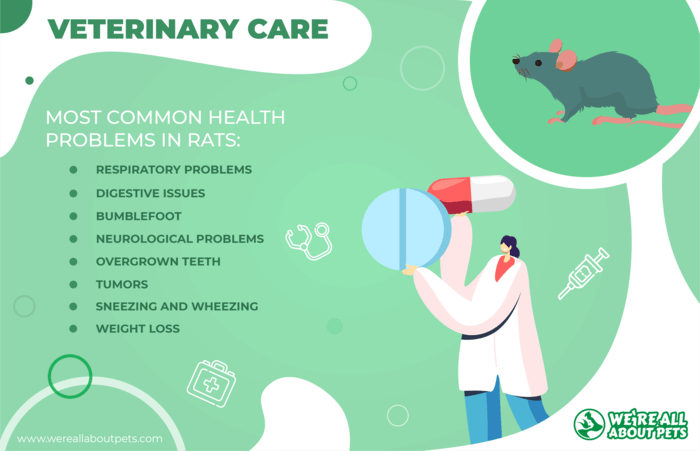
All pets are prone to getting sick, though feeding your rat a healthy diet is the best way to prevent that from happening.
Just in case, however, it’s a good idea to keep the number for a veterinarian on hand.
Just remember that not all vets are trained in rat care – you may need to find a small animal vet or an exotics vet. Take your rat to the vet within a few weeks of bringing him home for the first time to establish a baseline for his health. From there, you can just keep an eye out for new signs of illness.
Here are some of the most common health issues in rats:
- Respiratory problems
- Digestive issues
- Bumblefoot
- Neurological problems
- Overgrown teeth
- Tumors
- Sneezing and wheezing
- Weight loss
If you’re worried about the cost of veterinary care, you might be considering pet insurance.
The trouble is you’ll pay a monthly premium that might be more expensive than the cost of treatment. You may be better off putting what you’d pay each month into savings in case your rat needs emergency care.
Pet Rat Fun Facts
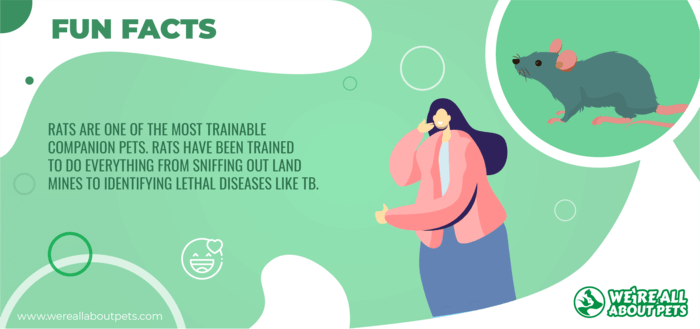
- Rats are one of the most trainable companion pets. Rats have been trained to do everything from sniffing out land mines to identifying lethal diseases like TB.
- A rat has scent glands on the bottoms of its feet that help it mark its territory and retrace its own steps when it is out foraging for food.
- Rats have short gestation periods of just 21 to 24 days. The average litter contains about 7 kits, though litters as large as 20 have been observed. Kits reach sexual maturity in just 5 weeks.
- The rat has two types of teeth – incisors and molars. The incisors are specialized for gnawing and are open-rooted which means they grow continuously throughout the rat’s life.
- Rats have an incredibly strong sense of smell with over 1,200 olfactory receptor genes. Elephants have 1,948, dogs have 811, and humans have fewer than 400.
- Wild rats live in large family groups and will actually go through a period of mourning if a member of the group dies. Pet rats should always be kept in pairs or groups.
- Rats are like guinea pigs in that they do not have the ability to vomit. They have a strong gastroesophageal barrier and stomach anatomy very different from that of a human.
Though rats may not be the first pet you think of, they’re definitely worth considering. Not only are they a lower maintenance alternative to traditional pets like cats and dogs, but they are very smart and entertaining in their own ways.
You may be surprised to learn just how much you love them!
Frequently Asked Questions
How long do rats live?
The average life span for a pet rat is only about 3 years. Proper rat care is essential to help your pet maximize his life span, so be sure to provide a healthy diet and act quickly at the first sign of health problems.
How much do rats cost?
When it comes to purchasing a pet rat, you may find a difference in price depending where you go. At the pet store, you’ll pay between $5 and $12 whereas a breeder might cost you $10 for a single rat and up to $40 for a pair. Don’t forget to factor in additional costs for your rat’s cage and additional supplies. You can expect to spend about $150 at the minimum to get set up with a new rat, including the rat’s first vet visit and spay/neuter surgery, if you choose to do it.
How big do rats get?
The average pet rat grows 9 to 11 inches long with up to another 8 inches in tail length. According to the American Fancy Rat and Mouse Association, pet rats grow up to 20 inches from nose to tail and adult male rats can weigh as much as 2 pounds.
What do rats eat?
Rats are omnivorous and have a bit of a reputation for anything they can get their paws on. A healthy diet for pet rats consists of a variety of foods including seeds, grains, nuts, fruit and vegetables. You might also consider a commercial rat food to ensure nutritional balance.
Are rats good pets?
Yes, many people are surprised to learn that rats actually make very good pets. Not only are they intelligent and entertaining, but they are also quite social and can be trained to do a variety of tasks. It also helps that they are fairly low maintenance and inexpensive to keep.
Are rats messy?
Rats are actually surprisingly clean animals, despite their reputation. Many rats keep their cages fairly tidy by choosing one specific area of the cage in which do to their business. The fact that they are kept in cages which contains the bedding helps with the mess as well.
Where do rats come from?
Rats can be found all over the world with different species in different regions. Fancy rats, the kind most commonly kept as pets, were developed from the brown rat or the Norway rat which colonized in Europe in the 18th century.
Do rats bite?
It’s a common fear that rats have a tendency to bite but a pet rat when properly cared for is no more likely to bite than another pet. Rats may bite when they feel cornered or threatened but are unlikely to bite unless provoked.
Do rats sleep?
Rats are generally nocturnal, but they can adjust to different schedules as needed. They tend to sleep in short bursts rather than long periods of time and won’t hesitate to forage for food during daylight hours.
How long are rats pregnant for?
Rats are prolific breeders thanks to a short gestation period of just 21 to 24 days. Female rats can breed throughout the year, producing as many as 5 litters over the span of 12 months.






